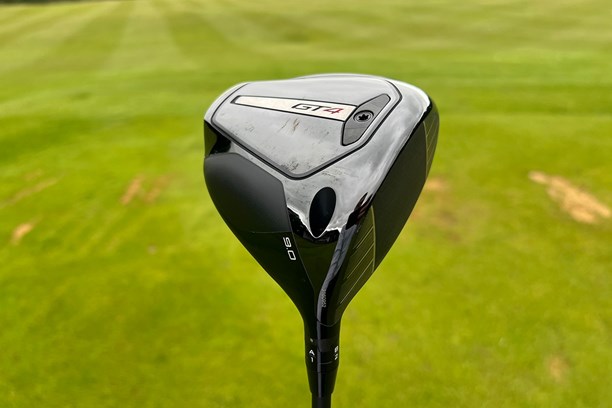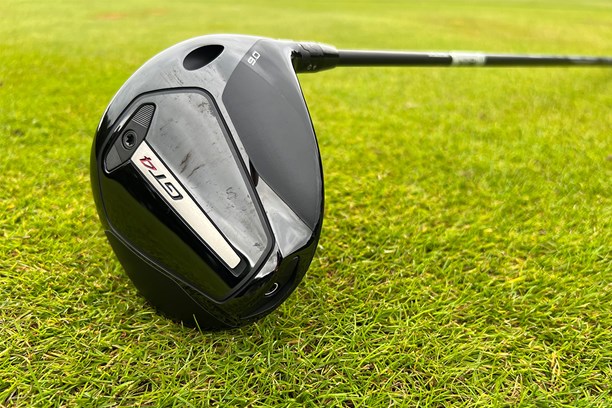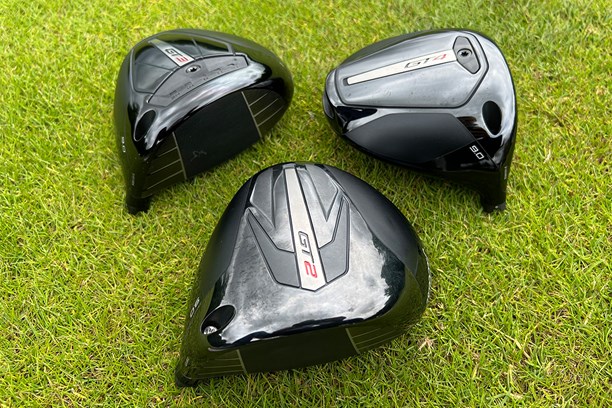A stable low-spin driver? The Titleist GT4 Driver Review
Last updated:
-
At a glance
- TG Rating
- Owner Rating
-
Pros
- A ball speed monster when struck well
- Lowest spinning model I've tried this year
- Taller face at 430cc will suit better-player eyes
-
Cons
- Smaller head means a smaller sweetspot
What we say...
With every low-spin driver comes danger from the drop-off on bad strikes. Has Titleist finally found the formula to achieve stability in a low-spin model?
Inherently when designing one of the best drivers, you have to make choices. You can either position CG (Center of Gravity) as far back in the head as possible in an effort to raise MOI (Moment of Inertia) and make a more forgiving golf club but one that falls down for power. Or, you can drag CG right up to the face, creating a club that can produce impressive ball speed numbers and very low spin, but at a cost of stability to off-center strikes.
Most drivers tend to be at the former end of the spectrum, with the recent trend towards 10K drivers the exemplar of this design characteristic. Manufacturers can’t be blamed for moving in that direction either, with the majority of golfers needing more help both with wayward strikes or getting the ball into the air more.
For some players though, spin and height are not their friends so moving into a weight-forward design can actually be more beneficial to their game, even with a drop-off in off-center performance.
This is where the new Titleist GT4 is looking to make an impression. Boasting updates to face design, crown material, and repositioned internal weight, Titleist is looking to offer a low-spin driver that doesn’t sacrifice as much stability as is expected from this category of club. The tech that makes this possible may just be some of the company’s most innovative in years.

Crown Glory
Whenever you’re moving CG into more extreme positions, it helps to have discretionary weight to play with. The difficulty with finding discretionary weight to move, in this case, more forward in the head is that it has to come from somewhere.
One of the ways that most manufacturers have gone down is to use Carbon Fiber. Lighter than titanium while also retaining a high level of strength, carbon fiber is becoming a mainstay across many different industries. Titleist, though, have been resistant to making this change.
Their argument has been fairly sound. When installing carbon crowns onto drivers, you have to glue directly onto the body and the epoxy used ends up negating any weight saved with the change of material. That, combined with the desire of Titleist’s staff players to avoid moving away from the classic metallic noise that Titleist drivers are known for, has made moving away from titanium a challenge for the engineers at Carlsbad.
This is where the new Thermoform process has been a game-changer. Thermoforming allows for plastic, like carbon fiber, to be pressed into more complex geometric shapes than can otherwise be achieved. With Thermoform, engineers have been able to incorporate the crown into the sole of the club, wrapping the edges around the sides of the head for a more secure fit. With the connection between the sole and crown, Titleist can now apply the epoxy holding the components together to the underside of the driver, meaning the weight of the glue now contributes directly to lower CG.
But what about the sound of the woods? That’s where the material used, PMP, is making such a big statement.
Proprietary Matrix Polymer is front and center of Titleist’s marketing this year and with good reason. Created in-house at the company’s R&D facilities, PMP is attracting interest from folks as far away as NASA. This space-age material has allowed Titleist to save that discretionary weight with the new crown design but what’s significant about this construction is the sound.
Low-spin stability
Best for Low-Spin


Pros
- A ball speed monster when struck well
- Lowest spinning model I've tried this year
- Taller face at 430cc will suit better-player eyes
Cons
- Smaller head means a smaller sweetspot
| Lofts: | 8º / 9º / 10º (RH/LH) |
| Shafts: | Project X Denali Red, Mitsubishi Tensei 1K Blue, Project X HZRDUS Black 5th Gen, Mitsubishi Tensei 1K Black + Premium Upcharge Graphite Design Tour AD-VF, Tour AD-DI, and Tour AD-UB |
| Grip: | Titleist Universal 360 Grip |
| Weight Options: | 11g (FWD) / 3g (AFT) |
- Proprietary Matrix Polymer material
- Thermoform Process Crown
- Split Mass Internal Technology
- Improved Aerodynamics
- Enhanced SpeedRing VFT
- Tour-Inspired Graphics
Drop a piece of PMP on a surface and you’ll be met with the unmistakable rattle of metal. At least, that’s what it seems like. In fact, the engineering team has been able to manufacture a carbon-based product with a frequency closer to metal than anything else on the market.
This means that Titleist now has the technology to make the weight-savings it wanted while also appealing to its core audience feedback requirements.
Hitting the GT4, and all the GT line, is somewhat surreal. You know that this isn’t metal but your brain struggles to believe it. I found the change to result in a richer, more powerful sound to the driver though still with what I believed to be metal at its core. Given a few more swings, this noise has become completely comfortable, indistinguishable from my memories of the TSi and TSR drivers of the recent past.
Less weight, more power
Sounds aside though, Titleist have been able to take that saving in weight and apply it lower and further forward in the head using their Split Mass Construction.
“The discretionary mass we gained from the Thermoform Crown allowed us to move our center of gravity exactly where we want it,” says Stephanie Luttrell, Director of Metalwood Product Development. “How did we distribute the mass savings? We split the mass, isolating it incredibly low and forward, and taking the remainder of the mass and pushing it to the back of the head. We were able to get incredible speed along with stability from that balanced mass position.”
You’ll find Split Mass in every GT head this year but used differently in each design. With GT4, where the goal is to make a spin-killer, weight has been closer to the face to produce some of the lowest launch and spin that Titleist has ever seen. Some weight, though, has been placed near the rear to add additional stability over last generation’s TSR4.

So we can see how GT4 can produce low spin, but what about ball speed, the crucial second aspect of long drives?
TSR4 actually shared more in common with TSR2, with the company’s Multi-Plateau Variable Face Thickness (VFT) featured in both for ball speed retention on off-center strikes. With GT4, Titleist has re-engineered VFT to include SpeedRing, the face technology from TSR3 meant to increase central ball speeds, creating a face design that pushes limits from the middle but also offers additional help and stability on strikes that find the heel or toe.
Finally, the shape of the driver has gone back into the lab to improve the aerodynamics on offer, helping maximize your speed out from the energy you can deliver into impact.
Great things
Drivers in the modern era are big. If you’ve ever held a full 460cc model next to anything pre-2005 you know what I mean. And that’s not a complaint. To paraphrase Uncle Ben, with great size comes great forgiveness.
When forgiveness goes up though, typically so does launch, and if you’re looking for a low-spin model this isn’t going to do you any favors. To help maintain stability without allowing the face to expose too much loft, the GT4 has been made to a size of 430cc. This keeps dynamic loft (and therefore spin and launch) down while also not overly impacting off-center performance.
Coupled with a swappable front and back weight at 11g and 3g, you can create a relatively forgiving product with GT4, although if that’s your need I’d still suggest looking at GT2 or GT3 before jumping to GT4.

Taking to the course
With everything I’d learned with the Titleist fitting team about GT4, I was excited to get it in my hands and see how low we could go. Typically I create too much spin from my drivers but as I can still suffer from mishits, I’ve never liked to steer too far into low-spin heads due to their unforgiving nature.
Unfortunately, GT4 hasn’t done much to change my mind on that. That’s not to say I didn’t enjoy my time with GT4. When you find the middle of this driver, the feel is just like the rest of the GT family with a clear punchiness to the feedback. When I managed to square the face, we did see spin numbers below both GT3 and GT2.
For me, the problem was matching where the face was pointing up with my target line. When you play a driver with the weight this concentrated at the front of the head you also move it closer to the toe of the club, making the head want to resist turning over. Because of this, most of my drives ended up pushed or sliced out to the far left (far right if you’re right-handed).
I think my parting thoughts on GT4 largely reflect what I’ve already said. Yes, if you only care about maximizing your potential length at the cost of everything else then GT4 can do that job. Or if you suffer from a high hook that rears its head far too often then I’d happily recommend the new low-spin Titleist model.
But for the 95% not in that category, looking at GT2 and GT3 will still be the better option.
About the author

Lewis Daff
Lewis Daff joined the Today’s Golfer digital team in 2024, having spent more than a decade in both big box golf retail and independent stores, working as a club fitter and builder.
Experienced with every level of golfer, from beginner to professional, he has achieved Master Fitter and Builder status with most major manufacturers, including Mizuno, Taylormade, and Callaway, helping him to cement both a wide and deep knowledge base. Lewis specializes in Clubs, Shafts, Training Aids, Launch Monitors and Grips.
In Lewis’ bag is Titleist GT3 Driver (9º) with Fujikura Ventus Black, Titleist GT2 Fairway Wood (15º), Wilson Staff D9 Forged 3-iron, Srixon ZX7 MKii Irons (4-PW), Titleist SM9 Wedges (52º, 60º), Toulon San Diego Putter, and Callaway Chrome Tour Ball.
Talk to Lewis about why steel shafts are now dead and graphite is the only way forward or any other equipment you’d like to debate via his email.
Product Information
Titleist GT4 Driver
RRP: $649.00 / £579.00 + $849.00 / £749.00 (Premium)
Lofts: 8° / 9° / 10° (RH/LH)
Head Size: 430cc
Lie: 58.5°
Standard Shaft Length: 45.5”
Stock Shaft Options: Project X Denali Red / Mitsubishi Tensei 1K Blue / Project X HZRDUS Black 5th Gen / Mitsubishi Tensei 1K Black
Premium Upcharge Shafts: Graphite Design Tour AD-VF / Tour AD-DI / Tour AD-UB
Stock Grip: Titleist Universal 360 Grip

